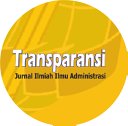Reformasi Birokrasi Pengadilan Agama di Indonesia: Apakah hanya Sekedar Formalitas ?
DOI:
https://doi.org/10.31334/transparansi.v5i2.2659Keywords:
Policy Implementation, Religious Courts, Integrity Zone,Abstract
One of the stressings of President Jokowi's government is governance to accelerate the achievement of bureaucratic reform goals contained in the 2020-2024 bureaucratic reform roadmap, especially related to clean and accountable bureaucracy, and excellent public services, it is necessary to build an Integrity Zone (ZI) in the Religious Courts (PA). The purpose of this study is to analyze the Implementation of the Bureaucratic Reform Policy in the West Sumatra Religious Court with research locations in PA Padang, Pariaman, Payakumbuh, Batusangkar, and Talu. Qualitative descriptive research methods. Data were collected through documentation studies and interviews. Then the data is analyzed through the stages of data collection, data condensation, data display, and finally conclusion. Based on the results and analysis of research, it shows that the implementation of ZI in religious courts in West Sumatra has not been well internalized due to several factors, namely (1) the leverage component consists of two, namely aspects of fulfillment and reform. The five research locus of PA Padang, PA Pariaman, PA Payakumbuh, PA Batusangkar, and PA Talu still focus on fulfilling documents only. So that the reform aspect does not occur significant changes in the dynamic organizational structure and so do human resources that are still lacking in Ber-AKHLAK (service, accountable, competent, harmonious, loyal, adaptive, and collaborative); and (2) the impact of ZI implementation on customer satisfaction by looking at the results of public satisfaction surveys and the corruption perception index is very good.References
Creswell, J. W. (2016). Research Design. Quantitative, and Mixed Method Approach. Fourth edition. Pustaka Pelajar.
Hariany, Z. (2014). Analisis Indeks Kepuasan Masyarakat (Ikm) Terhadap Pelayanan Publik di Kantor Pengadilan Tinggi Banten. Jurnal Teknik Industri USU, 5(2), 17–21.
Ichsan, R. N., Surianta, E., & Nasution, L. (2020). Pengaruh Disiplin Kerja terhadap Kinerja Pegawai Negeri Sipil (Pns) di Lingkungan Ajudan Jenderal Daerah Militer (Ajendam) - I Bukitbarisan Medan. Jurnal Darma Agung, 28(2), 187. https://doi.org/10.46930/ojsuda.v28i2.625
Indianto, A. (2018). Agama di Indonesia. Indonesia Investment, 11(2), 1–159.
Mansyur, R. (2015). Keterbukaan Informasi di Peradilan dalam Rangka Implementasi Integritas dan Kepastian Hukum (Information Transparency in the Court in Order to Implement Integrity Implementation and Legal Certainty). Analisis Standar Pelayanan Minimal Pada Instalasi Rawat Jalan Di RSUD Kota Semarang, 3, 103–111.
Moleong, L. J. (2010). Metodologi Penelitian Kualitatif. Remaja Rosdakarya.
Prasetya, A. G. (2019). Mengintegrasikan Reformasi Birokrasi Dengan Inovasi Sektor Publik. Jurnal Analis Kebijakan, 1(1). https://doi.org/10.37145/jak.v1i1.23
Sugiono. (2010). Administrative Research Methods (equipped with R & D methods). Alfabeta.
Suryatman, H. (2015). Revolusi Pelayanan Publik Pelayanan Publik Berbasis Hati dan Teknologi Informasi. Jurnal Pendayagunaan Aparatur Negara Reformasi Birokrasi Menuju Pemerintahan Kelas Dunia, 5(V), 177–189.
Susanto, S., Iqbal, M., & Supriyatna, W. (2020). Menciptakan Sistem Peradilan Efisien dengan Sistem E-Court pada Pengadilan Negeri dan Pengadilan Agama Se-Tangerang Raya. JCH (Jurnal Cendekia Hukum), 6(1), 104. https://doi.org/10.33760/jch.v6i1.287
Wardah, R. Z., & Dkk. (2020). Penerapan E-Court di Pengadilan Agama Pasuruan. 1.
Zulyani, E. P. (2020). Agile Government dalam Mewujudkan Birokrasi yang Berkelas Dunia. Spirit Publik: Jurnal Administrasi Publik, 15(1), 78. https://doi.org/10.20961/sp.v15i1.40717
Downloads
Published
Issue
Section
License

This work is licensed under a Creative Commons Attribution-ShareAlike 4.0 International License
Please find the rights and licenses in Transparansi : Jurnal Ilmiah Ilmu Administrasi By submitting the article/manuscript of the article, the author(s) agree with this policy. No specific document sign-off is required.
- License
The commercial use of the article will be governed by the Creative Commons Attribution license as currently displayed on Creative Commons Attribution-ShareAlike 4.0 International License.
2. Author(s)' Warranties
The author warrants that the article is original, written by stated author(s), has not been published before, contains no unlawful statements, does not infringe the rights of others, is subject to copyright that is vested exclusively in the author and free of any third party rights, and that any necessary written permissions to quote from other sources have been obtained by the author(s).
3. User Rights
Transparansi : Jurnal Ilmiah Ilmu Administrasi spirit is to disseminate articles published are as free as possible. Under the Creative Commons license, Transparansi : Jurnal Ilmiah Ilmu Administrasi permits users to copy, distribute, display, and perform the work for non-commercial purposes only. Users will also need to attribute authors and Transparansi : Jurnal Ilmiah Ilmu Administrasi on distributing works in the journal and other media of publications.
4. Co-Authorship
If the article was jointly prepared by more than one author, any authors submitting the manuscript warrants that he/she has been authorized by all co-authors to be agreed on this copyright and license notice (agreement) on their behalf, and agrees to inform his/her co-authors of the terms of this policy. Transparansi : Jurnal Ilmiah Ilmu Administrasi will not be held liable for anything that may arise due to the author(s) internal dispute. Transparansi : Jurnal Ilmiah Ilmu Administrasi will only communicate with the corresponding author.
5. Miscellaneous
Transparansi : Jurnal Ilmiah Ilmu Administrasi will publish the article (or have it published) in the journal if the article’s editorial process is successfully completed. Transparansi : Jurnal Ilmiah Ilmu Administrasi editors may modify the article to a style of punctuation, spelling, capitalization, referencing and usage that deems appropriate. The author acknowledges that the article may be published so that it will be publicly accessible and such access will be free of charge for the readers as mentioned in point 3.
Every accepted manuscript should be accompanied by "Copyright Transfer Agreement"prior to the article publication.











